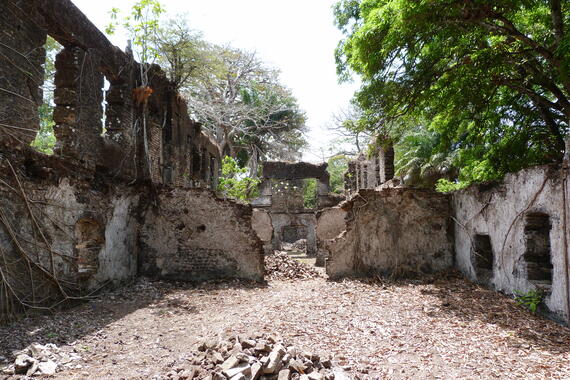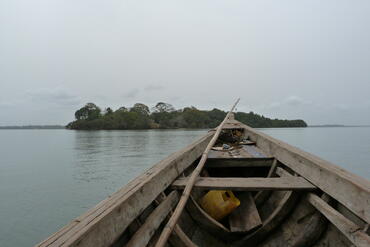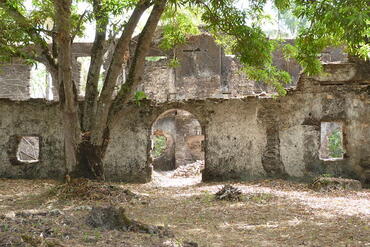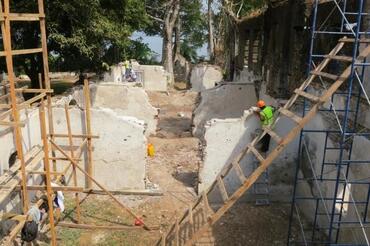Bunce Island: A Memorial to the Dark History of Man’s Inhumanity

A few miles north of the port city of Freetown, rising from the waters of the Sierra Leone River, a small, uninhabited stretch of land silently carries a built testament to one of the darkest periods in humankind’s history. Besieged by overreaching tree roots and invasions of wild grass, empty, stone-brick shells of old buildings double as remnants of one of the most lucrative slave trading operations in West Africa.

Between the late 1600s and 1807, Bunce Island’s fortified British trading post and ancillary buildings, known collectively as a slave castle, served as an international trade center and the pass-over point for commercial ships transporting enslaved people to the West Indies and North America. The island housed merchants’ quarters, a gunpowder magazine, a slave house, a cookhouse, and an office tower. The Chief Agent’s residence at the center of the castle stood in front of a “slave yard,” where captive men, women, and children were held before being loaded aboard commercial ships by the hundreds.
Located along the “rice coast” of West Africa, Bunce Island was considered a privileged access point for slave trade operations targeting individuals from rice cultivating areas to sell to rice plantation owners in South Carolina and Georgia. Bunce Island captives were also sold in Northern colonies such as New York, Rhode Island, Connecticut, and Massachusetts. Over more than a century, an estimated 30,000 people were sent to slavery from Bunce Island.

“Thousands of Africans passed through Bunce Island’s doors on their way to a life of captivity in the Americas.” Isatu Smith, former Head of the Monuments and Relics Commission of Sierra Leone (MRC), was WMF’s Project Manager at Bunce Island during its three-year project there in partnership with MRC, launched in October 2017 and completed in July 2020. “It is very important as a memorial to the dark, dark history of man’s inhumanity to man, and as a site of memory.”
Bunce Island stands as a testament to a transformative and traumatic period in local and regional history whose impact on the Atlantic world continues to this day. Its unique historical and social significance transcends national boundaries, giving us insight into how our built environment, passed down from generation to generation, bears witness to the truths of the past and the present.
The urgent need to recognize the history of the Atlantic slave trade and its lasting effect on our lives was made clear this summer when massive protests swept across the United States, calling for social justice in the name of Black Lives Matter and demanding acknowledgment not only of the systemic racism pervading society but also of its deep roots. Roots which extend all the way across an ocean, back to Sierra Leone.

WMF’s work at Bunce Island, supported by the Ambassadors Fund for Cultural Preservation, secures the survival of one of the most important heritage sites in West Africa which, despite its significance, remains underrepresented. A new visitor infrastructure, including an interpretation center, pathways, and information signs, will help tourists engage with the site and raise awareness of Bunce Island’s role in the Atlantic slave trade and its legacy.
Organized trainings for tour guides focused on a detailed history of Sierra Leone and the relationship between the United States Gullahs, descendants of enslaved people from the rice coast, and Sierra Leoneans. “I cannot underscore enough the importance of Bunce Island and especially Sierra Leone’s role in the transatlantic slave trade,” Isatu Smith, who headed the trainings, explained. “It’s very important that this place is preserved so that descendants of captives who were taken will come back to visit this place as a pilgrimage to their ancestors who were enslaved.”
WMF’s work at the site, stabilizing a large section of standing ruins, raising awareness through educational outreach and community engagement, and training local craftspeople, will, in line with the objectives of the MRC, encourage the development of a national consciousness surrounding the history of slavery in Sierra Leone. It will also ensure Bunce Island lives on as a unique cultural memorial of Africa’s intersection with the United States.
